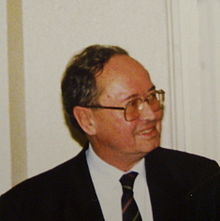Rolf Baehre
Rolf Baehre (born February 28, 1928 in Lehrte ; † May 31, 2005 in Baden-Baden ) was a German civil engineer and professor of steel construction at the University of Karlsruhe . He became known in Germany, England and Sweden primarily for his commitment to lightweight steel construction and light metal construction and made a significant contribution to the further development of technologies in this sector.
Life
Rolf Baehre spent his youth as the son of the building contractor Karl Baehre in Lehrte and completed a manual apprenticeship with a final journeyman's examination before studying civil engineering at the TH Hannover from 1949 to 1954. After graduating, he went to Sweden, where he has worked in the engineering office of Tekn.dr. Arne Johnson, head of the department, was responsible for research and development of new construction methods. In 1978 he was appointed to the chair for steel and light metal construction at the University of Karlsruhe as successor to Otto Steinhardt .
Professional background
Rolf Baehre carried out research at the Royal Technical University (KTH) in Stockholm while he was working in the Stockholm engineering office. In 1958 he obtained his teknologie licentiate and in 1968 he obtained his doctorate in tekn.dr. with a work on rectangular plates under single load attack and a work on theoretical and experimental investigations on elasto-plastic material . This essentially concerned the application of plastic hinge theory to aluminum structures. In 1969 Baehre became professor and in 1971 finally full professor for steel construction at the KTH. The list of his publications is long: he dealt with plate and disk load-bearing effects, building structures, lightweight steel construction and light metal construction in the most varied of forms, connections in lightweight construction as well as the creation of the basis for the industrial production and practical application of thin-walled metal components. As the head of the research institute for steel, wood and stones at the University of Karlsruhe , lightweight metal construction received a wide range of suggestions both at home and abroad for decades. His solidarity with the international lightweight construction community was expressed in the honorary doctorate awarded to him by the University of Salford, UK in 1988. As a test engineer for structural engineering for all disciplines (metal construction, solid construction, wood construction) he worked from 1978 until reaching the age limit with a branch in Pforzheim and was a member of the Baden-Württemberg recognition committee for test engineers. As head of the research institute for steel, wood and stones at the University of Karlsruhe, he worked with Friedrich Mang . Numerous scientific papers, which are of great importance for the professional world, originate from this time. Among other things, the experimental-scientific basis for a number of well-known structures in the new Berlin was developed here (e.g. investigations into the cast-iron nodes of the Humboldthafen Bridge / Mang).
Bodies
Baehre developed the DASt guideline 016 for the dimensioning and structural design of supporting structures made of thin-walled, cold-formed components, was chairman of the TC7 of the European Convention for Steel Construction, a member of the German Committee for Steel Construction (DASt) and numerous national and international bodies. Under his leadership, Eurocode 3 Part 1.3 for thin-walled cold-formed components was developed.
Private
Rolf Baehre was married and had three children from his first marriage. He cultivated an open and trusting relationship with his colleagues and employees. He enjoyed living and working in Karlsruhe because, as he used to say, it is in the middle of Europe.
literature
- Obituary in the Stahlbau magazine, Volume 74, 2005, Issue 9, p. 717
- Abstract academic work in the journal Stahlbau, Volume 57, 2000, Issue 3, pp. 93/94
| personal data | |
|---|---|
| SURNAME | Baehre, Rolf |
| BRIEF DESCRIPTION | German civil engineer and professor for steel construction at the University of Karlsruhe |
| DATE OF BIRTH | February 28, 1928 |
| PLACE OF BIRTH | Taught |
| DATE OF DEATH | May 31, 2005 |
| Place of death | Baden-Baden |
